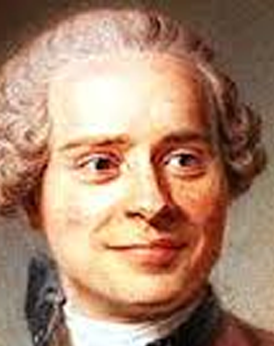Personnes
Jean le Rond d'Alembert
16 Nov 1717 - 29 Oct 1783
d'Alembert began under a cloud, as the illegitimate child of Claudine de Tencin and one Chevalier Destouches, and he has ended under a cloud (his errors in statistics are better remembered than his many positive contributions). But in life he was an effective practitioner and propagandist of the new learning of his time, and a major figure in the French Enlightenment.
His mother abandoned him on the steps of the chapel of St-Jean-le-Rond de Paris. The chapel placed him in an orphanage, whence he was adopted by a glazier's wife. His natural father paid for his education, beginning with the Jansenist Collège des Quatre-Nations. In those anti-Jesuit surroundings, d'Alembert studied philosophy, law, and the arts, graduating in 1735 at the age of eighteen. After further study, he became an advocat in 1738. His first contribution to knowledge was a 1739 communication to the Académie des Sciences, pointing out errors in Reynaud's standard work on mathematical analysis. A treatise on refraction followed in 1740. The next year, d'Alembert was made a member of the Académie des Sciences. In the years following, he published a notable series of treatises on mechanics (1743), fluids, vibrating strings, and the precession of the equinoxes.
Talent and looks won him admittance to the Paris salons, where he met Diderot. When the stalled Encyclopédie project was reorganized in 1747, d'Alembert became Diderot's co-editor, with responsibility for mathematics and the sciences. d'Alembert's contributions included an introduction ("Discours Préliminaire Des Éditeurs"), surveying knowledge since mediaeval times, giving the plan of the work, and calling for advances in knowledge. It was notable for its stance on the sources of knowledge, among which religion (classed as a mere branch of philosophy) was not included. Practical arts were emphasized: whatever can materially improve the human condition.
d'Alembert's introductory essay, and the Encyclopédie itself (eventually in 35 volumes, with 71,818 articles) was a major broadside of the French Enlightenment. As such, it attracted the opposition of the Church,and the Encyclopédie was officially suppressed in 1759, though it was unofficially tolerated due to the support of such j\highly placed persons as Madame de Pompadour. By the time the Encyclopéedie was finished, in 1777, d'Alembert, by then sixty years of age, had contributed more than a thousand articles to it.
Some of these aroused more than clerical opposition. In "Croix ou Pile" ("Heads or Tails"), d'Alembert argued, against the common sense of his time and ours, that the chance of all Heads in two tosses of a coin was not 1/4, but 2/3 - counting both the HT and TH options as a single "mixed" option. This and other cranky positions were later appreciated as challenges to certain unexamined assumption in statistics - challenges which d'Alembert lacked the technical equipment to carry to a conclusion. He was also lacking in other qualities. In his public controversies with Euler, and especially with Daniel Bernoulli, he found himself, for the first time, up against opponents who not only thought more cogently than he did, but also wrote in a simpler and more accessible style.
Right or wrong, and he was often right, d'Alembert's contributions to mathematics continued to the end. So did his organizational contribution: he had been elected to the Académie Française in 1754 (having earlier been elected to the Berlin Academy in 1746, and to the Royal Society in 1748), and became its Permanent Secretary in 1772. His 1769 patronage of the young Laplace, by all odds France's greatest mathematician of that period, speaks well for him, as does his support of Euler at Berlin (despite their differences) and the young Lagrange And there was an appropriate continuation: Laplace's 1774 memoir on probability not only takes up some questions where d'Alembert had left them, but carries them to a more systematically satisfying point: the point at which modern mathematical statistics may be said to have begun.
Some of d'Alembert's work has survived in the form in which he himself left it. His analysis of vibrating strings led to the discovery of d'Alembert's operator, which is still part of theoretical physics. His text for the convergence of a series remains a part of basic mathematics.
d'Alembert's doubts continued to find expression until his death, some of them in the eight volumes of papers published as Opuscules Mathématiques (1761-1780). Nor was his large output wholly lacking on the strictly humanistic side: his translation of excerpts from Tacitus, made in his late years, was much admired at the time.
However the technical controversies may come out, d'Alembert helped to create the world in which we life: the world in which such questions as these can be debated. The foundling became in the end a founding statesman of the modern intellect.
"Rara temporum felicitate ubi sentire quae velis et quae sentias dicere licet" - Tacitus Histories 1:1.
13 Dec 2005 / Contact The Project / Exit to Reference Page
